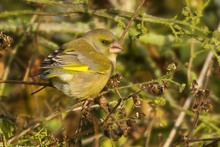

Biodiversity
Action
Plan
Other birds of shrubs and scrub
Include Linnet, Reed Bunting, Tree Sparrow and Yellowhammer
Grasshopper Warbler emits a high-pitched reeling song from dense vegetation to attract a female after which it is usually unnoticed.
It feeds mainly on insects, hunting restlessly through vegetation.
It is fairly localised in Barnsley. Numbers may have increased in recent years, especially in the Dearne Valley, with possibly around 60 pairs breeding here.
Birds of Shrubs and Scrub. Shrubs, whether in gardens, parks, woodland glades and edges, or in dense or scattered scrub, support a range of bird species which use them for nesting, shelter and cover, and for feeding on the seeds, berries and insets found in them.
Greenfinch, Bullfinch, Dunnock, Song Thrush and Mistle Thrush are local priority species together with the summer visiting Grasshopper Warbler and Cuckoo. #
Dunnock hops about in low vegetation and around the edge of lawns, feeding on small insects, worms and seeds.
It’s a small, streaky, brown bird, with a blue-grey head and breast and thin, pointed beak,
It inhabits any well vegetated areas with shrubs, brambles and hedges. They keep largely on the ground, close to cover.
Dunnock is common and widespread in Barnsley,often seen in gardens and parks, with in excess of 2000 territories.
Conservation measures
- Retention of shrubs, hedges and scrub, especially in n urban areas
- Appropriate planting in new developments, including native shrub species
Associated Habitats
- Gardens and green spaces with shrubs in built-up areas.
- Scrub.
- Other habitats with shrub, bramble or bracken cover.
Dunnock nest in low-growing, dense hedges or shrubs, building a nest out of twigs and moss and laying up to five eggs from late April to June.
The chicks hatch after about two weeks and fledge two weeks later. They may have up to three broods.
Dunnock’s decline in numbers may have been caused by habitat loss and predation although numbers have been more stable recently.
Dunnock
UKBAP 2007 Priority Species
NERC Section 41 Species of Principal Importance
Amber ListBoCC
General protection W&C Act
Bullfinch. The black cap, grey back, and red breast of the male Bullfinch make it quite distinctive. Both male and female display a white rump in flight.
It feeds on buds, seeds, berries and fruit; its young fed insects.
It prefers thorn thickets, aged hedgerows and woodland edge with extensive undergrowth.
It is a thinly distributed resident breeding bird, quite wide-spread in Barnsley with up to 300 pairs.
Conservation measures
- Maintain scrub and shrubs
- Maintain varied woodland structure including shrub understorey at edges
- Management of hedgerows in three year cycle
Associated Habitats
- Shrubs and scrub
- Hedgerows,
- Woodland edge
- Parks and gardens
- Orchards
Bullfinches usually nest in shrubs, such as Hawthorn and Blackthorn, making a flimsy nest out of twigs and moss in thick bushes.
They tend to lay their eggs between May and July, incubate them for 12-14 days with the young fledging after 14-16 days. There may be 2 -3 broods.
Loss of hedgerows and areas of scrub and shrubs has been the main cause of Bullfinch decline.
Song Thrush
UKBAP 2007 Priority Species
NERC Section 41 Species of Principal Importance
BoCC5 Amber List
General protection W&C Act
Song Thrush, a once common bird in our gardens, has a brown head, wings and back, and a cream breast covered in dark brown spots.
Found in habitats with shrubs and scrub cover, it likes damp areas to provide snails and worms to feed on. It also takes berries during winter months.
In Barnsley, it is a widespread, common resident breeding bird with up to 1000 pairs, but now in low numbers on farmland.
Song Thrush build their neat, thickly lined, cup-shaped nest, low down in any suitable cover; in thick hedges, mature scrub and urban gardens.
They nest early in the spring and usually have two to three broods between April and July.
Habitat loss, use of pesticides including slug pellets which kill or contaminate snails, predation and disturbance contribute to decline.
Conservation measures
- Retain hedgerows, shrubs and scrub
- Maintain good cover
- Appropriate planting in new developments, including native shrub species
- Avoid disturbance and use of pesticides.
Associated Habitats
- Shrubs and scrub
- Gardens & parks in urban areas
- Field margins with hedgerows
Mistle Thrush
BoCC5 Red List [IUNC2 NT]
General protection W&C Act
Mistle Thrush, a larger thrush, sings perched high on a tree and makes its rattling call in flight when disturbed. It may defend bushes against rivals for berries.
It has greyish-brown upperparts, a long tail and a plump white breast with heavy, dark brown spots. In flight, it has long wings and whitish tail edges.
In Barnsley it is a widespread, fairly common resident breeding bird with up to 400 territories.
Conservation measures
- Retain shrubs and trees with berries and damp grassland with worms etc
- Retain mature trees in parks and gardens
- Avoiding disturbance and use of pesticides
Associated Habitats
Areas with both mature trees and grassland such as Parks and gardens, farmland, open woodland and wood pasture.
Mistle Thrush feeds on worms and other invertebrates as well as seeds and berries in autumn and winter,
An early breeder, Mistle Thrush usually breed from February to May, with up to 3 broods
It has a big, messy nest in the fork of a tree, typically 2-9 metres high
It decline is thought to be reduced brood size, decreased young survival rates, and fewer natural food sources.
Conservation measures
- Retain areas of low scrub & damp well-vegetated habitat
- Manage habitat to prevent maturation of scrub
Associated Habitats
- Damp areas of scrub or with abundant scattered bushes.
- Edges of reedbeds.
- Thick grassland
- New forestry plantations
Grasshopper Warbler requires thick ground cover, like bramble, low bushes to sing from, and a rich source of invertebrate food near its nest.
It nests on the ground or a little above it in thick vegetation, breeding from April to late July, often with two broods,
Loss of habitat through drainage and scrub clearance may be causes of its decline.
Grasshopper Warbler
UKBAP 2007 Priority Species
NERC Section 41 Species of Principal Importance
BoCC5 Red List
General protection W&C Act
Bullfinch
UKBAP 2007 Priority Species
NERC Section 41 Species of Principal Importance
BoCC5 Amber List
General protection W&C Act
Summer visitors such as warblers also utilise shrubs and scrub for nesting and catching their insect food. Local Priority Species include Grasshopper Warbler. [Spotted Flycatcher is in the woodland bird section]. The Cuckoo too utilises shrubs when it lays its eggs in a Dunnock nest.
Other summer visitors using shrubs and scrub include
Blackcap, Cettis Warbler, Lesser Whitethroat, Spotted Flycatcher
Whitethroat.
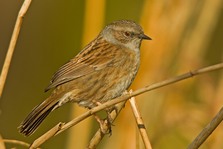
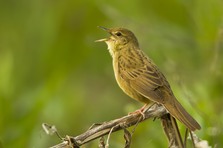
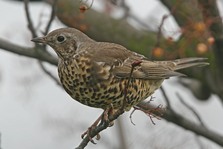
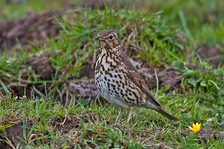
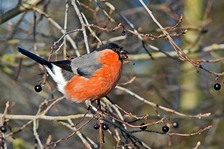
Conservation
- Maintaining populations of host species through habitat management
- Monitoring long-term trends and taking appropriate action.
Habitats
- Wide range of habitats incl those of host species:
- Shrubs & scrub: Dunnock
- Heathland & grasslands: Meadow Pipit
- Reedbed: Reed Warbler
Cuckoos lay their eggs in the nests of other birds, including Dunnock, who then raise their young. The male Cuckoo has the characteristic ‘cuckoo’ call.
They feed on insects, especially hairy caterpillars and beetles.
A summer visitor becoming more infrequent, with less then 50 breeding pairs in Barnsley, it is mainly found in lowland areas east of the M1 and in moorland fringe areas.
Cuckoos arrive from mid-April and leave by mid-July, the young in August and September.
They lay a single egg in the host bird nest, especially Dunnock, Meadow Pipit and Reed Warbler. A single female may lay an egg in up to 24 nests each year
Fewer host species numbers, host species’ breeding before Cuckoos arrive, less prey and other factors in migration and winter months, are possible causes of their decline.
Cuckoo
Migrant breeding bird
UKBAP 2007 Priority Species
NERC Section 41 Species of Principal Importance
BoCC5 Red List
Cuckoo image required
Birds of shrubs and scrub
Greenfinch,a chunky green and yellow finch with a twittering, wheezing song, has gone to the BoCC Red List in 2021 because of its recent national decline.
It has been a widespread and common breeding bird in Barnsley found, more recently found in urban and suburban areas with gardens, parks, allotments and other shrub-rich green spaces.
It feeds on large seeds especially cereal grains, and berries its young are fed on insects.
Conservation measures
- Maintain dense shrubs and thick hedgerows, including in new developments
- Management of hedgerows in three year cycle
- Maintain scrub and shrubs at woodland edges
Associated Habitats
- Shrubs and scrub
- Hedgerows,
- Woodland edge
- Parks and gardens
- Orchards
Greenfinch nest in dense shrubs, evergreens and overgrown hedges with breeding beginning in April with often 2 broods.
A recent decline in numbers has been linked to a disease that prevents the birds from feeding.
Other causes have been changes in farming practice resulting in loss of winter seeds, and the loss of areas of scrub and shrubs.
Greenfinch
BoCC5 Red List
General protection W&C Act
